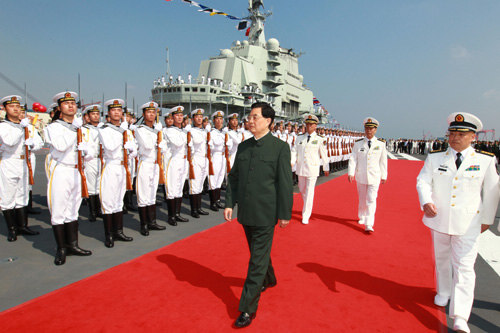|
 |
|
MILITARY REVIEW: Chinese President Hu Jintao, also Chairman of the Central Military Commission, inspects the naval guard of honor on the Liaoning on September 25 (ZHA CHUNMING) |
September 25 has become a hallmark day for China, especially its naval force, as the country's first aircraft carrier, the Liaoning, entered service.
Overseen by President Hu Jintao and Premier Wen Jiabao, the carrier was officially handed over by the China Shipbuilding Industry Corp. to the People's Liberation Army (PLA) Navy at a ceremony held at a naval base in Dalian, northeast China's Liaoning Province.
China is the 10th country in the world and the last among the five permanent members of the UN Security Council to have an aircraft carrier in active service. The United States, the United Kingdom, France, Italy, Spain, Russia, India, Thailand and Brazil all possess aircraft carriers.
"The delivery and commissioning of the first carrier are milestones in the PLA's history and embodies a major achievement of China's weaponry and equipment development, as well as its national defense modernization," said Premier Wen Jiabao at the handover ceremony.
Ge Lide, an associate professor at the PLA National Defense University (NDU), told the China News Service that Liaoning's entry into service will promote the PLA Navy's strategic transformation to become a blue-sea force able to operate on the high seas and raise the country's capabilities in handling non-conventional security threats.
An accomplished dream
The Liaoning is a conventionally powered carrier rebuilt from the former Ukrainian vessel Varyag.
Construction of the Varyag began in 1985 at a shipyard on the Black Sea. The vessel, with a displacement of around 60,000 tons, was designed to be among the largest carriers in the world at that time. But with the break up of the Soviet Union in 1991, the Varyag had been only two thirds completed before construction stopped. China bought the carrier's immense armored hull—with no engine, electricity or propeller—from the Ukraine in 1998 and began to refit the vessel in Dalian in 2002.
After 10 years of refitting, the aircraft carrier conducted its first sea trial in August 2011. Before its commissioning, the vessel had undergone 10 sea trials, with the longest one lasting 25 days in July.
"The main system of the Liaoning is the result of independent building and modification," said Yang Yujun, a spokesman for the Ministry of National Defense, at a press conference on September 27. He said the country has always adhered to the principle of independent innovation in building weaponry, relying on the country's own capacity for research and development.
After 10 years of refitting, the carrier is equipped with a China-made defense system able to launch attacks on missiles, aircraft and approaching vessels. It also uses a Chinese radar system that can evaluate risks and has a strong anti-interference capability. Since August 2011, the aircraft carrier has undergone 10 sea trials, with the longest one lasting 25 days in July.
During a recent online interview with people.com.cn, a website of the People's Daily, Major General Qiao Liang, a professor at the Air Force Command Institute, said, "Among medium-sized aircraft carriers around the world, there's no doubt ours is advanced."
Chinese military experts say aircraft carriers in active service are of vital importance to China, a country with more than 18,000 km of coastline and 3 million square km of territorial waters. But the process of acquiring its first aircraft carrier, which began more than 40 years ago, has been long and complicated.
Admiral Liu Huaqing, China's former naval commander known as the "father of China's aircraft carrier" because of his great support for the program, wrote in his memoir that, "China launched its initial plan for a carrier as early as 1970."
Besides the Varyag, China has imported three other carriers since the 1980s.
China's first imported carrier was the retired Melbourne from the Australian Navy in 1985. But the vessel proved nothing more than a pile of scrap metal, and it was dismantled in a shipyard in Guangzhou, southern Guangdong Province, where the iron was recycled.
Two decommissioned Russian vessels were imported and converted into theme parks in 1998—the Kiev in north China's Tianjin and the Minsk in Shenzhen in Guangdong.
Some Chinese military enthusiasts have questioned the significance of massive expenditures on refitting an old aircraft carrier rather than building a new one, and some have expressed doubts about the combat effectiveness of a refitted vessel.
| 